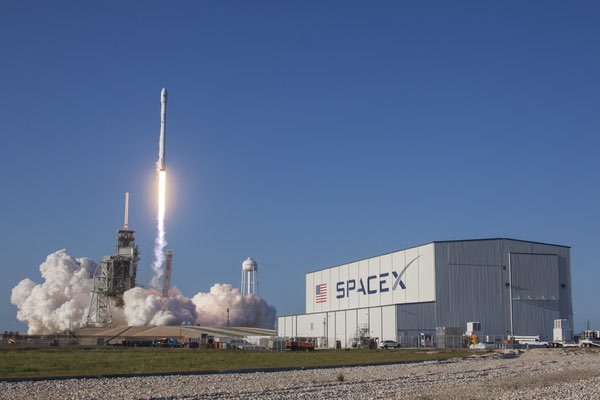A giant leap for Americaby Ajay Kothari
|
| The recent and upcoming developments in reusable rockets may allow for a paradigm shift in being able to establish large settlements on the Moon that, as a concept, was previously discarded due to costs involved. |
The SpaceX Falcon 9, Falcon Heavy, and DARPA’s XS-P are analyzed below for five flights each, made perhaps over one to two weeks, for “refueling” or “mated with” the upper stage already in orbit options. They yield almost 125, 285 and 100 t (tonne: one “t” here is one metric ton, equal to 1,000 kilograms or 2,205 pounds) to LEO. The SpaceX Falcon Heavy for example can place 276 or 294 tonnes to LEO using the refueling or mated options respectively, far superior to the SLS (Space Launch System) and would also be cheaper. All in all, this concept would offer about an option for access to the lunar surface ten times cheaper and without much additional cost of development that SLS has required so far. Also, this option does not have the hindrance associated with refueling depot of evaporation of fuel over time that is an obstacle to orbiting depot idea as the Trans Lunar injection would occur within about two weeks of the first flight.
More recent revelations by SpaceX of BFR or Blue Origin’s New Glenn reusable rockets have not been analyzed but may be of interest to do so in future, especially with liquefied natural gas (LNG) as fuel.
Access to space TSTO design options size comparison
We start with the proverbial access-to-space question: to LEO in this case. Astrox compared eight options, at the request of then Air Force Chief Scientist Dr. Mark Lewis and his assistant Dr. Ray Moszee, for the same payload of 20,000 pounds (44,000 kilograms), as close to apples-to-apples as possible, using the same code HySIDE©. All systems were built using object-oriented modules resulting in subsystems, then systems and then flown in system-of-system formulations. They are shown below.
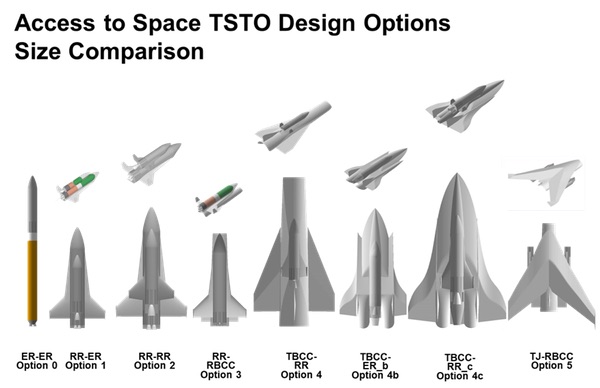 |
The Direct Operating Cost (DOC) were also computed and compared for 5 to 100 flights per year for these eight expendable, hybrid, and fully reusable options. To no one’s surprise, the reusable options reduced the DOC considerably as touted now by DARPA, SpaceX, Blue Origin, and others.
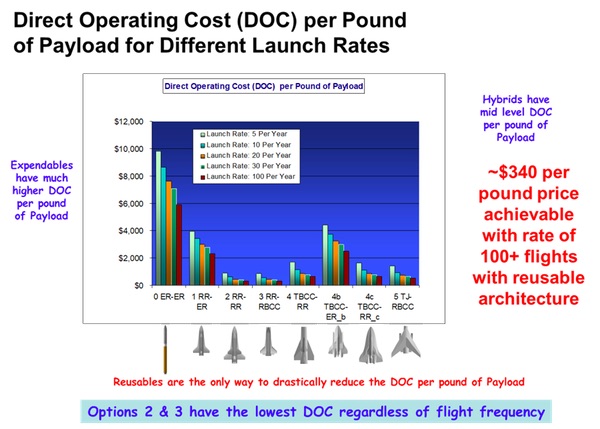 |
The next question was: can the reusability also have a positive impact on lunar access? The extension of the previous work was thus attempted using the subway diagram of the delta-v required for going from LEO to Lunar landing. The chart below prescribes the DeltaV required for trans-lunar injection, lunar intercept, and lunar landing. They are given in meters per second below.
| Is it possible to take full advantage of reusable first stage to place payloads on the lunar surface and how many such flights would be needed to do so? |
This part of the analysis, using this particular subway diagram, is approximate, and a different set of numbers for delta-v may be offerred by other parties, but since the results herein are fairly robust, the conclusions will still stand. It is also possible that that the total number of flights may vary between four and six instead of the five as supposed herein, but the clear path to this paradigm shift in cost and the possibilities will still remain. However if the number of flights needed were to go to a large number like ten or more, the proposition made here then is on shaky grounds indeed and may not be worth pursuing for the country.
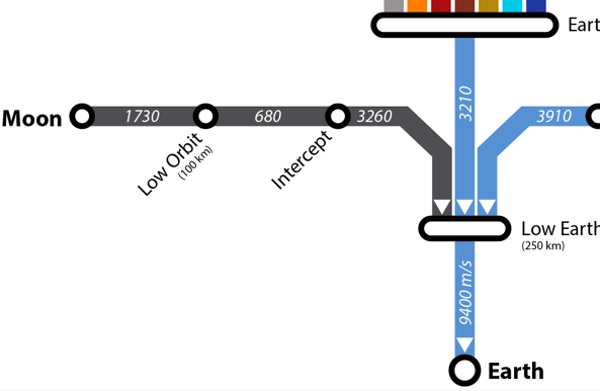 |
Given above is the subway diagram used. HySIDE was used to further compute the propellant fractions required for the fuels/engines of choice (hence the specific impulse, or Isp, obtainable), for Falcon 9 (RP/LOX), XS-P (LH2/LOX) and Falcon Heavy (RP/LOX) upper stages. A methane upper stage was not attempted but may yield better results at a possible Isp of about 382 secs as SpaceX claims. RP/LOX vacuum Isp of 345 and LH2/LOX vacuum Isp of a generic AUSEP engine of 464 were used.
The question to be answered is: is it possible to take full advantage of reusable first stage to place payloads on the lunar surface and how many such flights would be needed to do so? As mentioned above, the numbers computed are approximate, but they answer the question of whether we are in the ballpark of being able to do something highly useful for the country, have a paradigm shift in cost and consequently what we as a country can do which may be a paradigm shift as well: have colonies of hundreds of people on the Moon, instead of just a few.
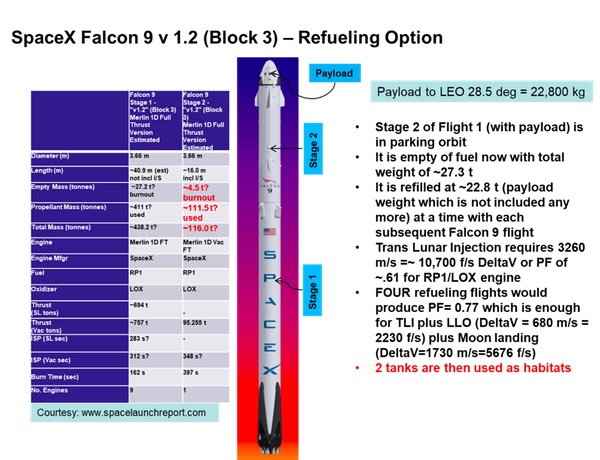 |
The idea calls for a flight of SpaceX Falcon 9 with the stage distributions as shown above. For this system, the upper stage empty weight is 4.5 tonnes for a 22.8 tonnes payload to LEO. With the upper stage now in orbit, subsequent flights of Falcon 9 with no payload, but instead additional propellant of the same mass, can be sent to the same orbit. We may then have two choices: to refuel the first empty upper stage with the additional 22.8 tonnes propellant or attach the second stage itself to the first upper stage already in orbit. This is done for three more flights, thus a total of five flights are exercised.
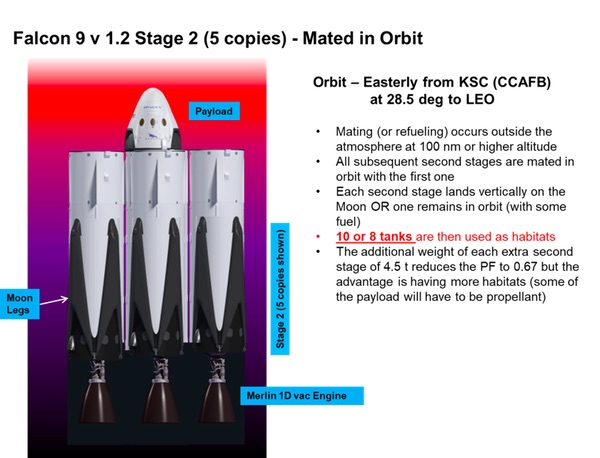 |
The figure above shows the second option discussed above, with five upper stages attached to each other. The landing legs are added herein for landing on the lunar surface. One of the five may remain in lunar orbit and other four, with eight fuel tanks, land on the lunar surface. The tanks then can be used as habitats for the settlers. Thus even the expendable upper stages, as designed, effectively become “reusable”.
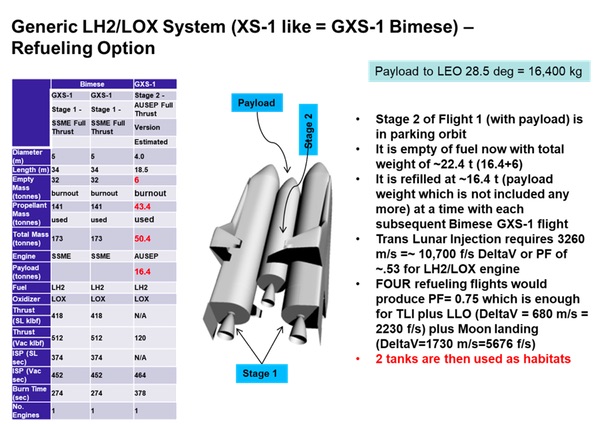 |
Another option is to use XS-1 (now designated as XS-P) in a bimese format. The Generic XS-1 shown here is a larger version at 173 tonnes each. This format then can place 16.4 tonnes in LEO, smaller than what Falcon 9 can do, but substantial nevertheless. A total of five such flights would also create the right propellant fraction for the upper stage(s), either using the refueling option or the mating option, to place 16.4 tonnes to the lunar surface. The refueling option again presents a higher propellant fraction but implies only two tanks to the lunar surface to be used as habitats.
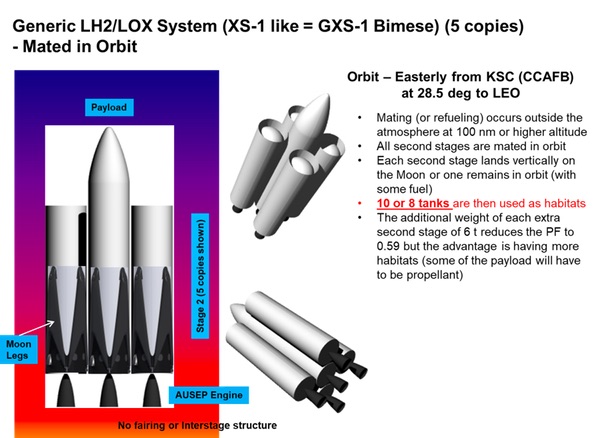 |
The mating option shown above would mean again that some of the original payload may have to be propellant but we are in the ballpark of being able to do the task.
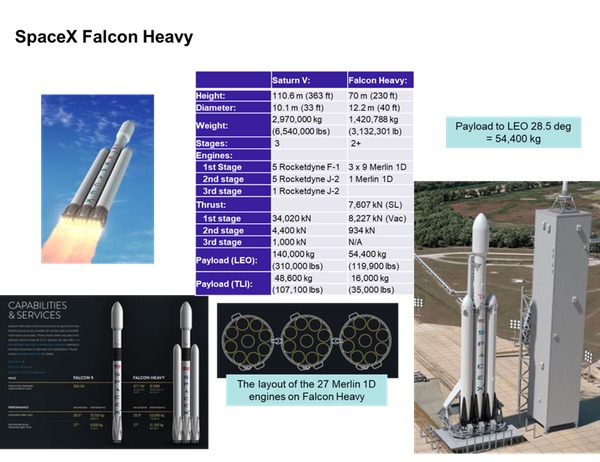 |
The Falcon Heavy option is the most attractive with its ability to place 54.4 tonnes to LEO and hence to the lunar surface. However this would mean the three first stages do RTLS (Return To Launch Site) for every flight. Five such flights would very comfortably provide the propellant needed to take all the upper stages plus the 54.4-tonne payload to the Moon.
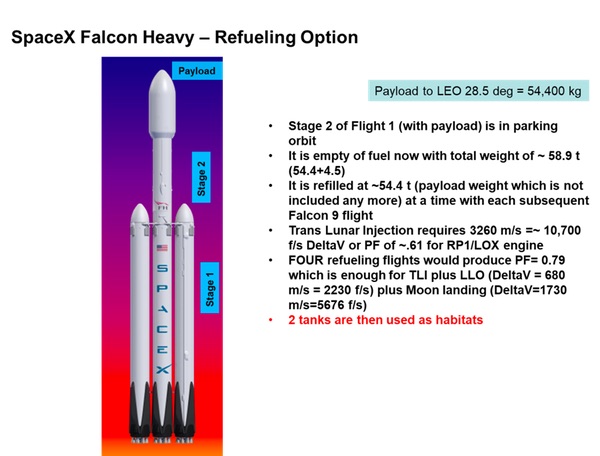 |
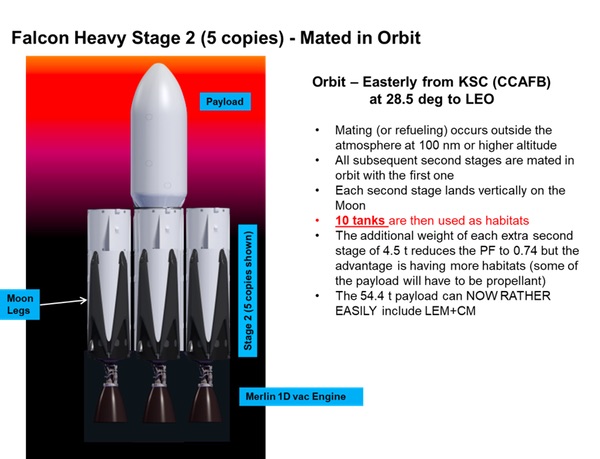 |
Either the refuel or the mating option is are quite attractive here, allowing for the margins of uncertainty. In fact, even four flights would provide for PF of 0.73 or 0.69 for the refueling or mated options respectively, both being enough to provide the DeltaV required for Lunar landing.
The quotation by SpaceX of $93 million for each flight of the Falcon Heavy amounts to about $2,740 per pound to the lunar surface if five total flights are assumed for the sake of computation. This can be a revolution and would allow private companies and the government to collaborate on the task, and reduce the cost of lunar habitats considerably: by almost a factor of ten, a lower cost than what SLS can promise. This, then, changes the paradigm for the country to have large settlements on the Moon for approximately the same price of getting there (if SLS were used instead), and use the tanks as habitats as well—perhaps many tanks if the mated option is used.
| It should be done as a synergistic effort between the government (NASA) and the commercial space companies. One scenario can be NASA managing the effort and the colonies with commercial companies providing the lift and other facilities. |
This allows us to have a large footprint on the Moon and be a lead country there. A real exploration of the Moon can then occur with hundreds of Americans living there at a time. People would stay for a few months at a time and the shifts can change with the cheaper transport costs. We would be much more competitive with China, Russia, or Europe, who will also establish their domains there invariably. Exploration for water can be manifested. The next steps then can potentially be Mars, other planets or their satellites, from the lunar surface. With a thousand people living there at a time, it would also be possible to manufacture liquid oxygen and hydrogen from solar electrolysis of the water on the Moon which would be much harder to do if we used SLS option instead with its limited use. Perhaps many more midsize American companies can also participate in different aspect of this venture, making a transition to commercial ventures a real possibility. There is thus a possibility to utilize the talents of many in the country rather than confining the task only to NASA or large companies.
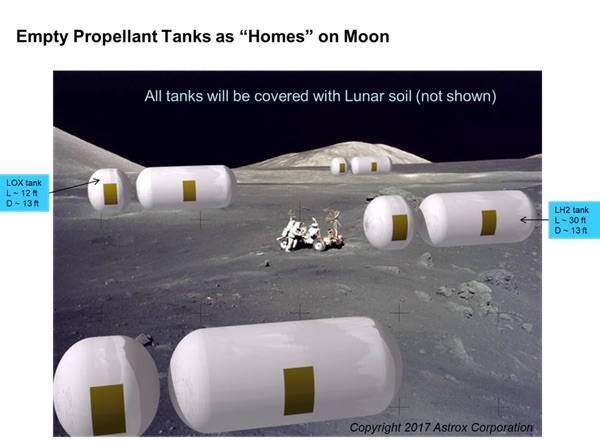 |
The tanks above are shown as potential habitats, shown to their relative sizes. The picture is a cartoon picture and the doors are likely to be on the end rather than where shown here. The tanks would also have to be covered in lunar soil as shown in the next picture.
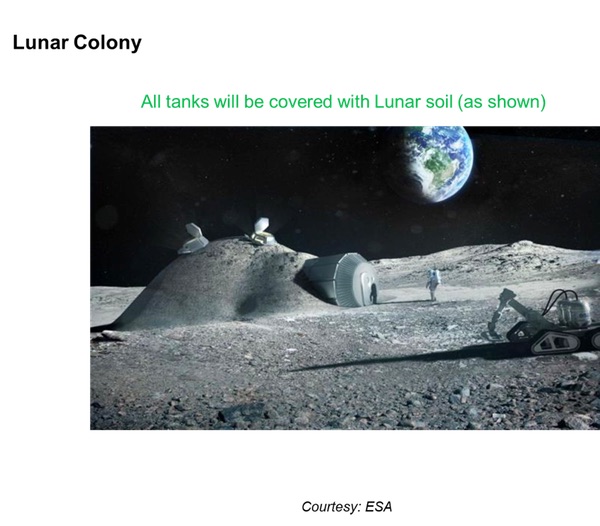 |
The chart below shows the ability of this concept to effectively place large amounts in LEO, Falcon Heavy being able to place far larger weight in LEO than SLS, and at much smaller cost than SLS.
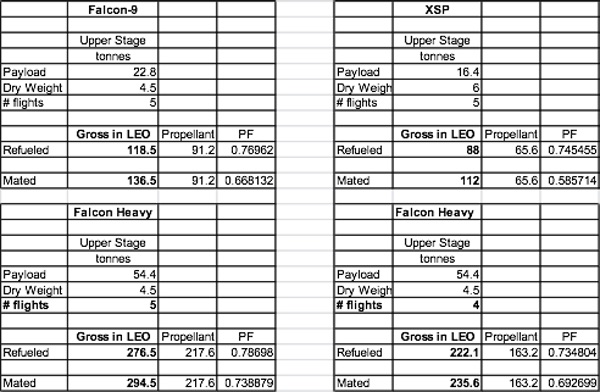 |
Concluding thoughts
- SpaceX is planning to charge ~$93 million per Falcon Heavy flight
- So ~54,400 kilograms payload plus 22.5 tonnes of tanks would cost about $465 million, which is about $6,047 per kilogran to Moon: less than what expendables cost
- This means a 150-kilogram person (including baggage) would cost less than $1 million
- GXS-1 could even be cheaper
- American lunar colonies are possible, tourism is possible, and all would form a needed first step for humanity before venturing out farther: a necessary condition
- It should be done as a synergistic effort between the government (NASA) and the commercial space companies. One scenario can be NASA managing the effort and the colonies with commercial companies providing the lift and other facilities.
- It is not easy, but is doable and at lower costs
